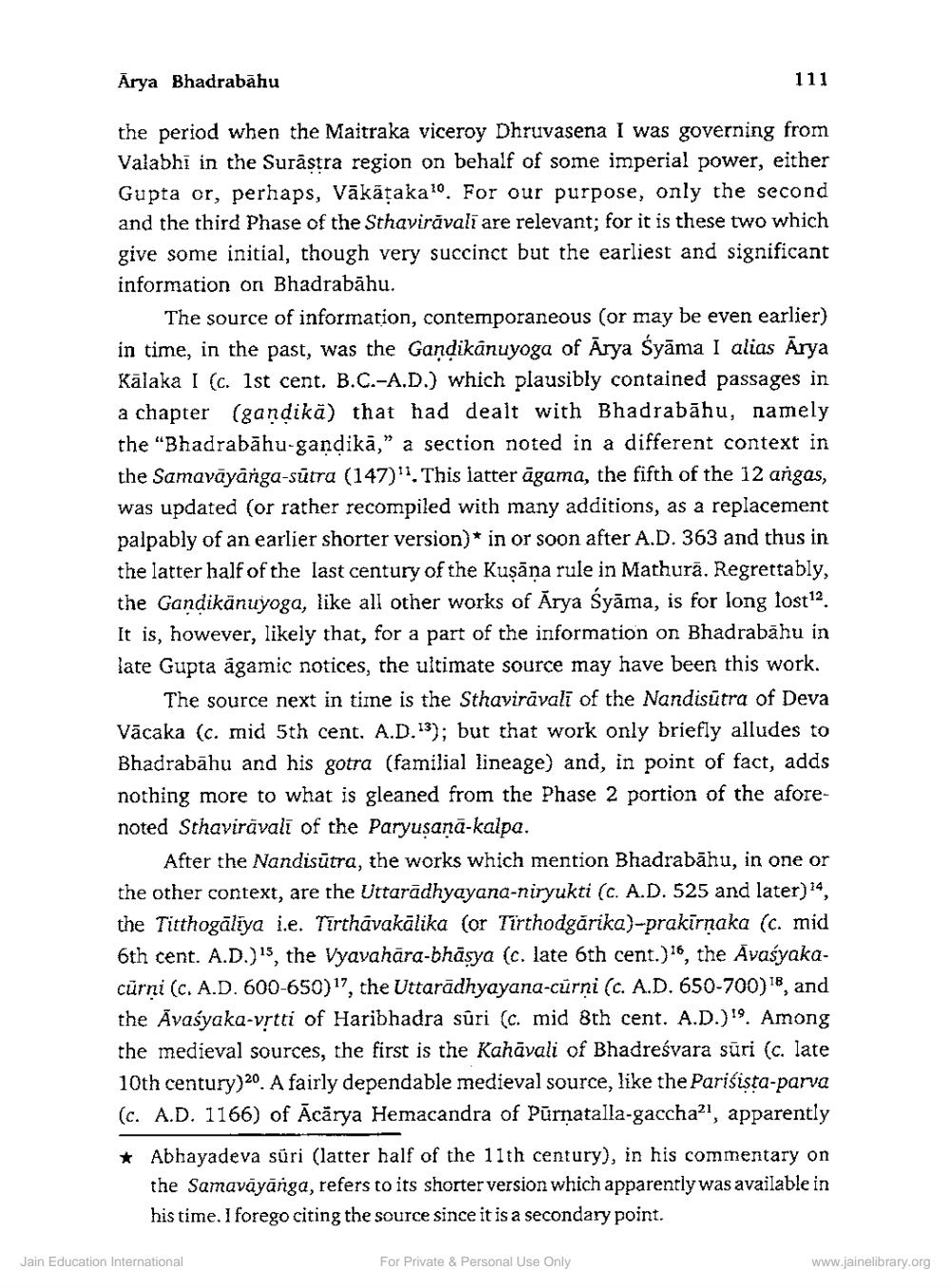Book Title: Arya Bhadrabahu Author(s): M A Dhaky Publisher: Z_Nirgranth_Aetihasik_Lekh_Samucchay_Part_1_002105.pdf and Nirgranth_Aetihasik_Lekh_Samucchay_Part_2 View full book textPage 4
________________ Arya Bhadrabāhu 111 the period when the Maitraka viceroy Dhruvasena I was governing from Valabhï in the Surāstra region on behalf of some imperial power, either Gupta or, perhaps, Vākāțakalo. For our purpose, only the second and the third Phase of the Sthavirávali are relevant; for it is these two which give some initial, though very succinct but the earliest and significant information on Bhadrabāhu. The source of information, contemporaneous (or may be even earlier) in time, in the past, was the Gandikānuyoga of Ārya Śyāma I alias Ārya Kālaka I (c. 1st cent. B.C.-A.D.) which plausibly contained passages in a chapter (gandikä) that had dealt with Bhadrabāhu, namely the "Bhadrabāhu-gandikā," a section noted in a different context in the Samavāyānga-sūtra (147)'. This iatter agama, the fifth of the 12 argas, was updated (or rather recompiled with many additions, as a replacement palpably of an earlier shorter version)* in or soon after A.D. 363 and thus in the latter half of the last century of the Kuşāna rule in Mathurā. Regrettably, the Gandikānuyoga, like all other works of Arya Syāma, is for long lost12. It is, however, likely that, for a part of the information on Bhadrabahu in late Gupta agamic notices, the ultimate source may have been this work. The source next in time is the Sthaviravali of the Nandisutra of Deva Vācaka (c. mid 5th cent. A.D. 13); but that work only briefly alludes to Bhadrabāhu and his gotra (familial lineage) and, in point of fact, adds nothing more to what is gleaned from the Phase 2 portion of the aforenoted Sthaviravali of the Paryusanā-kalpa. After the Nandisutra, the works which mention Bhadrabāhu, in one or the other context, are the Uttarādhyayang-niryukti (C. A.D. 525 and later) 24, the Titthogāliya i.e. Tirthavakālika (or Tirthodgărika)-prakırnaka (c. mid 6th cent. A.D.)', the Vyavahāra-bhäsya (c. late 6th cent.):6, the Avasyakacürni (c. A.D. 600-650)"?, the Uttaradhyayana-cūrni (c. A.D. 650-700), and the Avasyaka-vrtti of Haribhadra súri (c. mid 8th cent. A.D.)'9. Among the medieval sources, the first is the Kahāvali of Bhadreśvara sūri (c. late 10th century)20. A fairly dependable medieval source, like the Parisista-parva (c. A.D. 1166) of Ācārya Hemacandra of Purnatalla-gaccha”), apparently * Abhayadeva süri (latter half of the 11th century), in his commentary on the Samavāyānga, refers to its shorter version which apparently was available in his time. I forego citing the source since it is a secondary point. Jain Education International For Private & Personal Use Only www.jainelibrary.orgPage Navigation
1 2 3 4 5 6 7 8 9 10 11 12 13 14 15 16 17 18 19 20 21 22 23 24 25 26 27 28 29 30 31 32 33 34 35 36 37 38 39 40 41 42 ... 48
